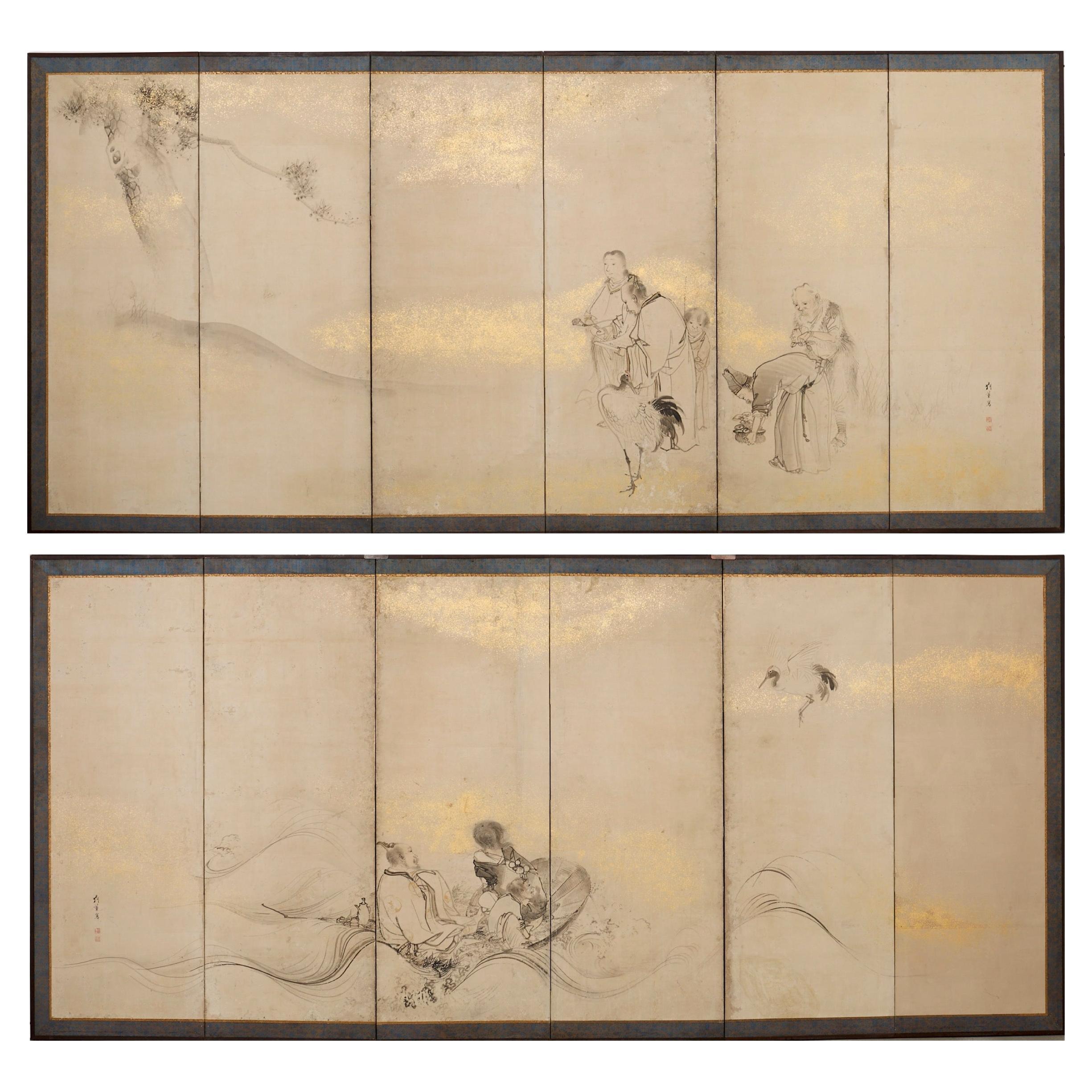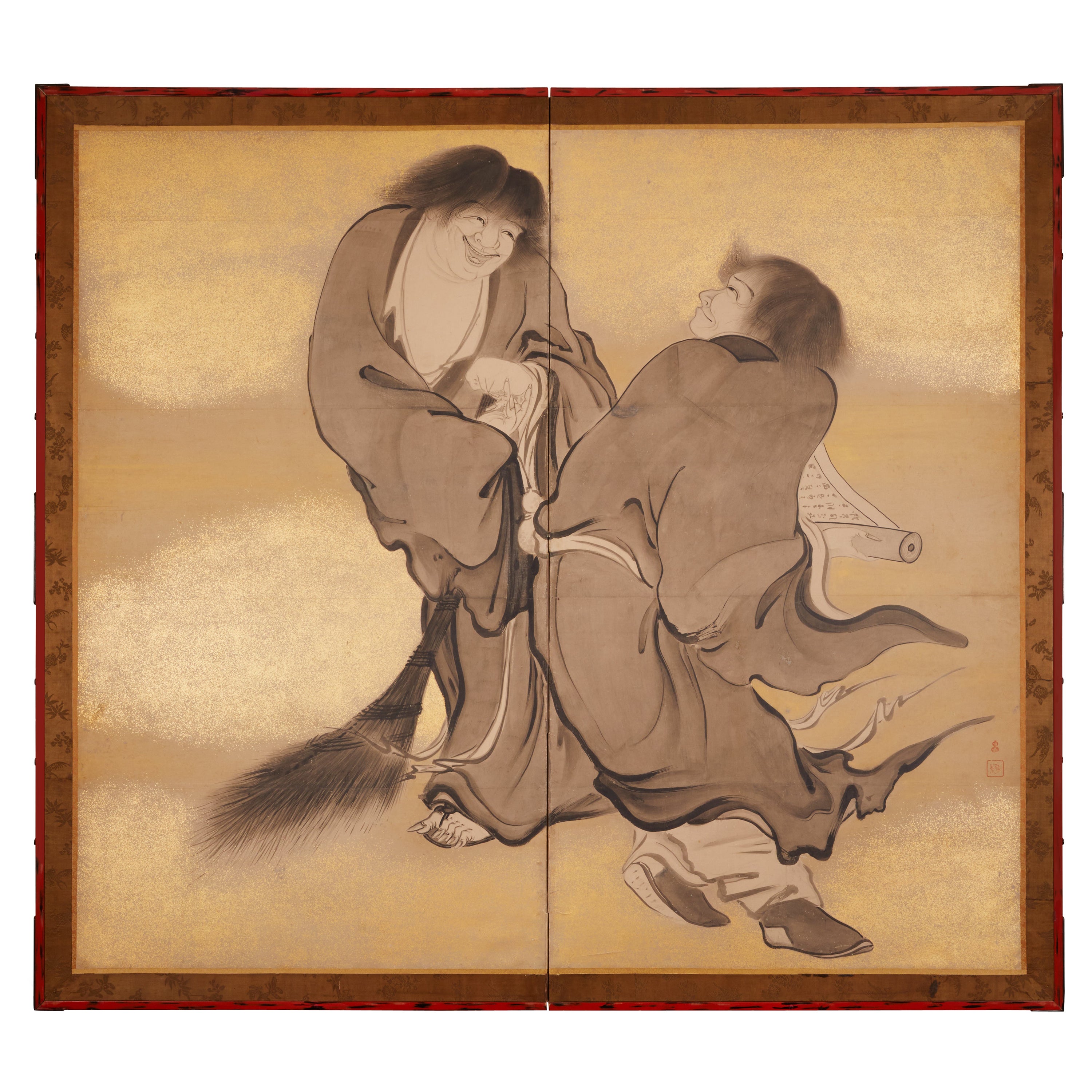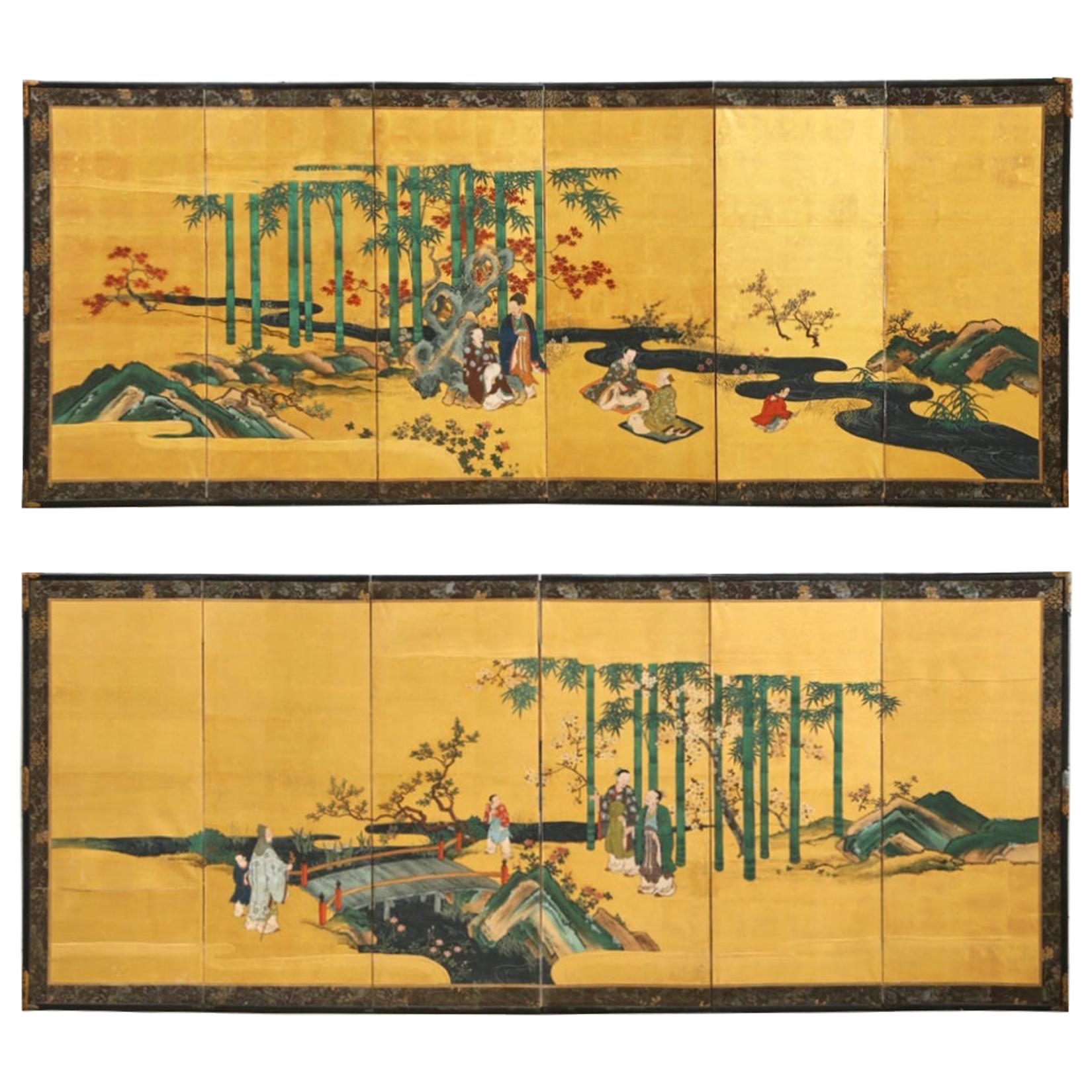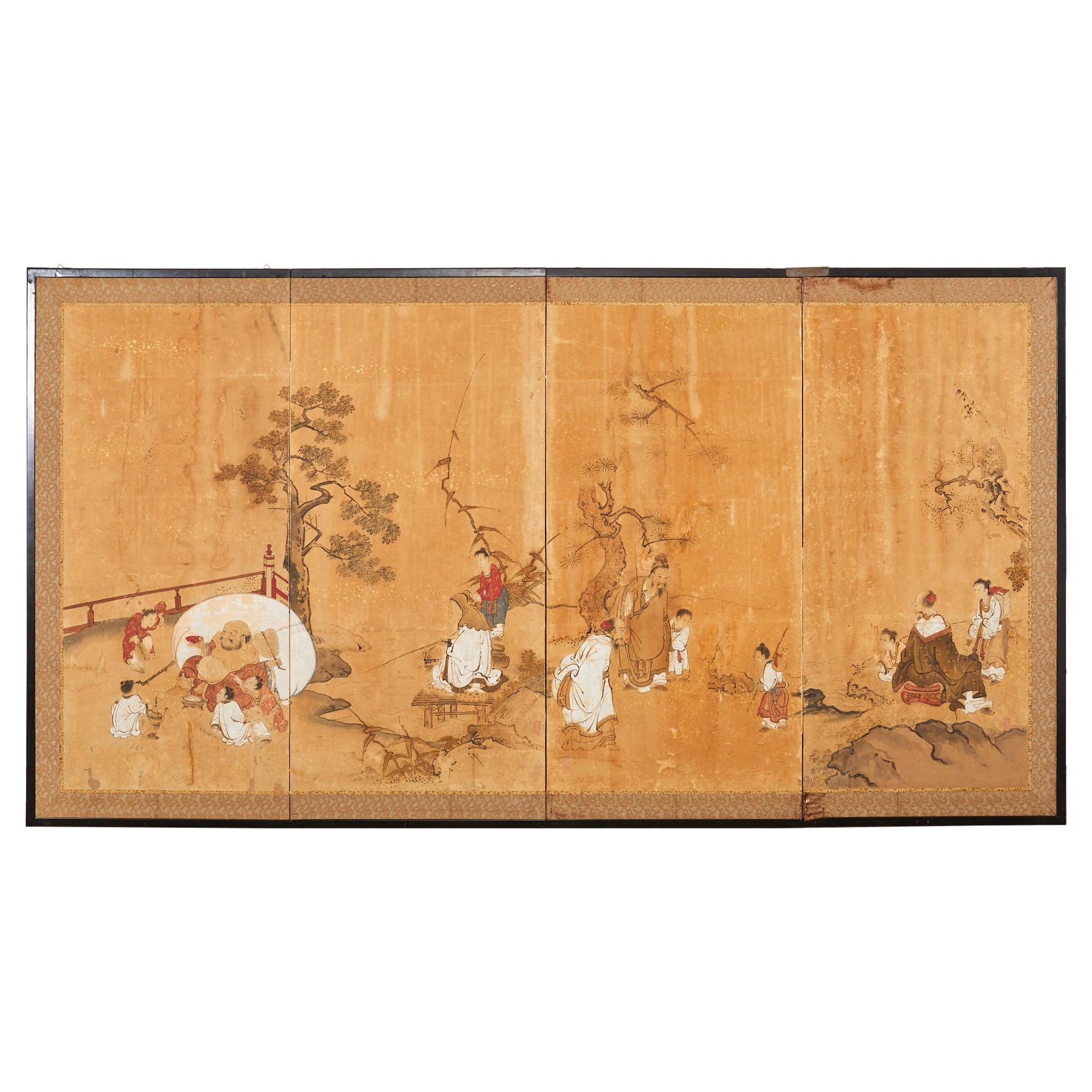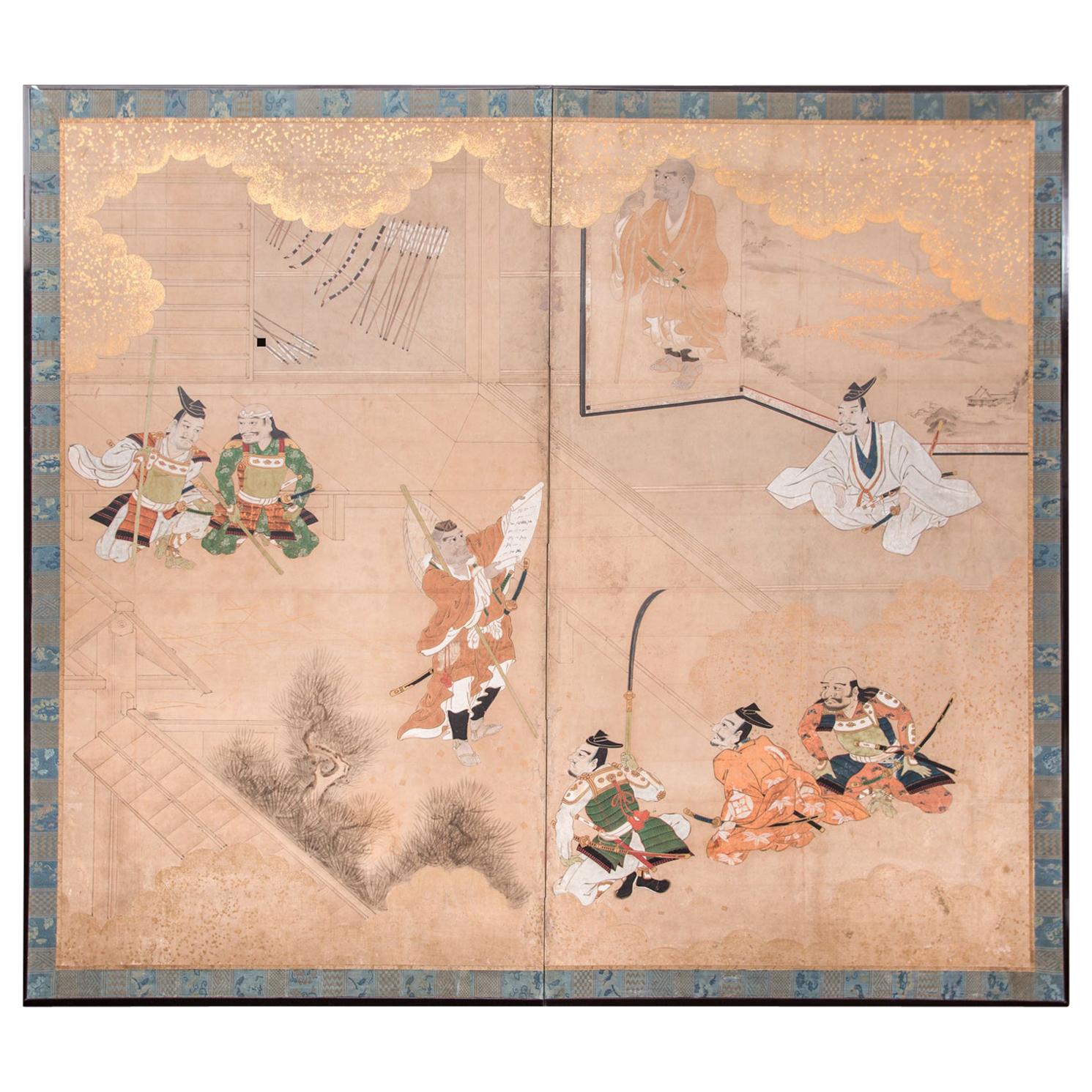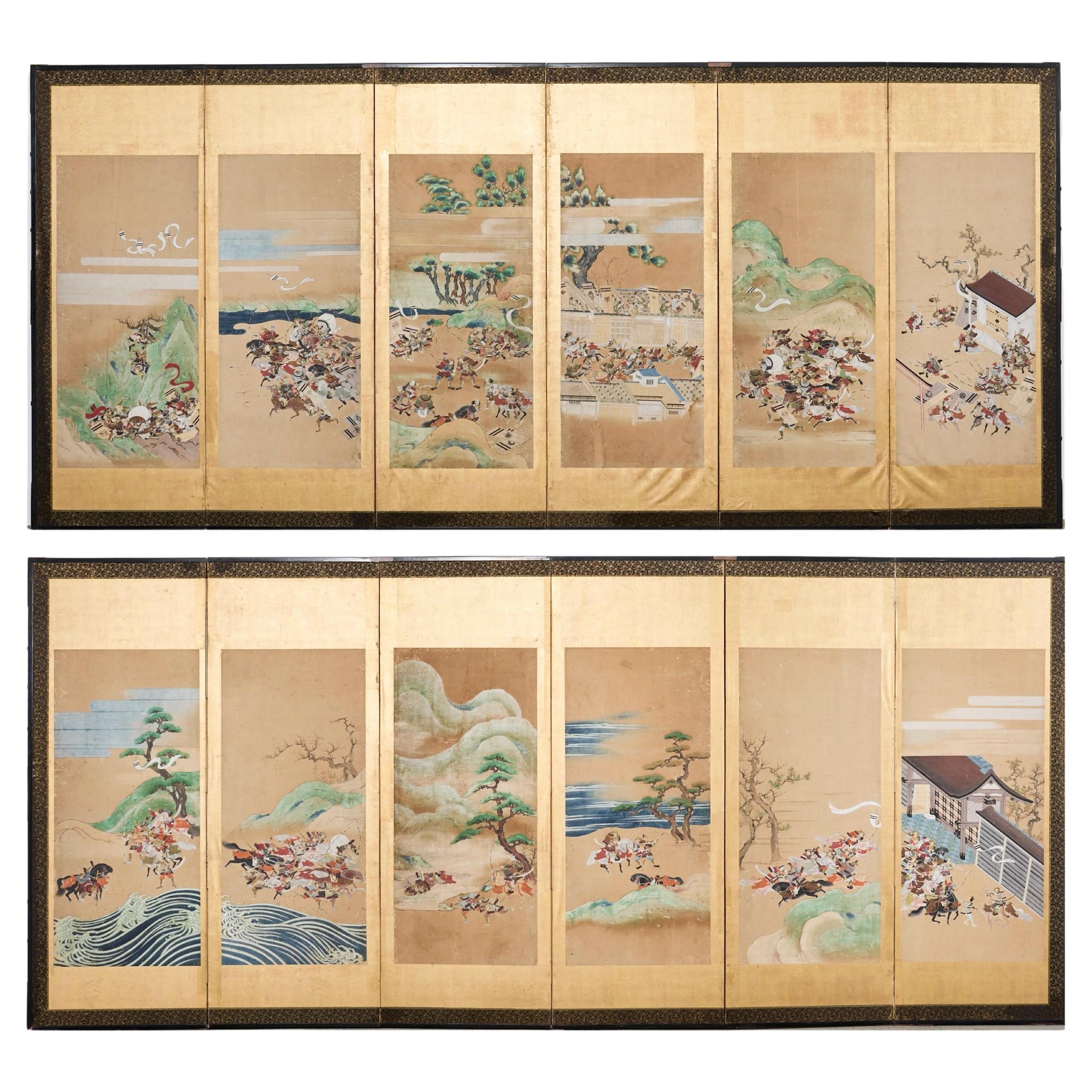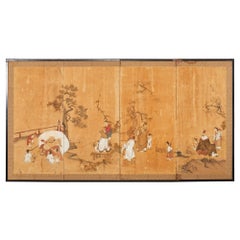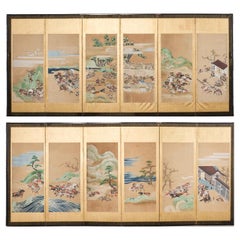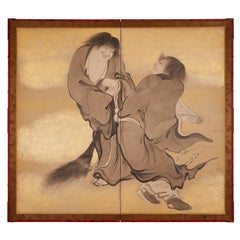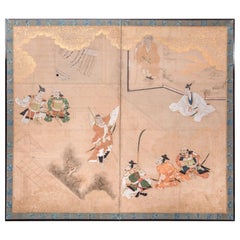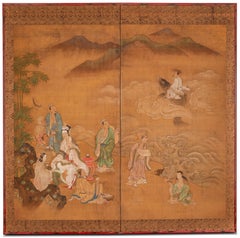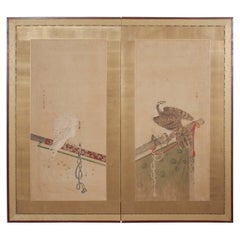Items Similar to Japanese Edo Two Panel Screen Deities by Yokoyama Kazan
Want more images or videos?
Request additional images or videos from the seller
1 of 21
Japanese Edo Two Panel Screen Deities by Yokoyama Kazan
$20,000
£15,048.14
€17,385.37
CA$28,265.22
A$30,690.54
CHF 16,252.88
MX$376,178.04
NOK 201,135.84
SEK 190,062.72
DKK 129,757.26
About the Item
Whimsical Japanese late Edo period two-panel screen circa 1800 by Yokoyama Kazan (Japanese 1784-1837). The screen depicts four of the seven Gods or deities of good fortune. Hotei, Benten, Fukurokuju, and Bishamonten. Maruyama-Shijo School ink and natural color pigments on hand-crafted mulberry paper with gold leaf flecks throughout. Signed with a seal on the bottom right side. Set in a natural wood frame with a textured silk border. Beautifully crafted painting by Kazan who lived and worked in Kyoto, Japan. He studied under Hijikata Torei, and Ganku. He then turned to Matsumura Goshun and the Shijo School. Kazan was a very famous Edo period influencer and his works are displayed in museums around the world.
- Dimensions:Height: 61 in (154.94 cm)Width: 70 in (177.8 cm)Depth: 0.75 in (1.91 cm)
- Style:Edo (Of the Period)
- Materials and Techniques:
- Place of Origin:
- Period:
- Date of Manufacture:1800
- Condition:Repaired: Old repairs. Wear consistent with age and use. Old repairs as expected. Age appropriate wear with a thin repaired tear on left side center as seen in photos,.
- Seller Location:Rio Vista, CA
- Reference Number:1stDibs: LU1555226984132

About the Seller
5.0
Erin Lane Estate is based in the San Francisco Bay Area, and its team of furniture restorers, art curators, professional appraisers and Asia specialists sources prime vintage and antique furniture from the finest estates in Northern and Southern California. Erin Lane Estate specializes in Hollywood Regency, McGuire, Chinese and Japanese pieces.
Diamond Seller
Premium sellers with a 4.7+ rating and 24-hour response times
Established in 2000
1stDibs seller since 2015
3,049 sales on 1stDibs
Typical response time: 2 hours
- ShippingRetrieving quote...Shipping from: Rio Vista, CA
- Return Policy
Authenticity Guarantee
In the unlikely event there’s an issue with an item’s authenticity, contact us within 1 year for a full refund. DetailsMoney-Back Guarantee
If your item is not as described, is damaged in transit, or does not arrive, contact us within 7 days for a full refund. Details24-Hour Cancellation
You have a 24-hour grace period in which to reconsider your purchase, with no questions asked.Vetted Professional Sellers
Our world-class sellers must adhere to strict standards for service and quality, maintaining the integrity of our listings.Price-Match Guarantee
If you find that a seller listed the same item for a lower price elsewhere, we’ll match it.Trusted Global Delivery
Our best-in-class carrier network provides specialized shipping options worldwide, including custom delivery.More From This Seller
View AllPair of 18th Century Japanese Edo Screens of Chinese Immortals
Located in Rio Vista, CA
Mesmerizing pair of late 18th/early 19th century Japanese Edo period byobu screens by Shibata Gito (Japanese 1780-1819). The paintings depict Chinese immortals in a dreamy landscape....
Category
Antique 18th Century Japanese Edo Paintings and Screens
Materials
Silk, Wood, Paper
Pair of Japanese Edo Six Panel Screens the Seven Sages
Located in Rio Vista, CA
Fantastic pair of 19th century Japanese late Edo/early Meiji period six-panel screens titled The seven sages of the bamboo grove. The Kano school screens...
Category
Antique 19th Century Japanese Edo Paintings and Screens
Materials
Brass, Gold Leaf
17th Century Japanese Edo Four Panel Screen Hotei with Chinese Sages
Located in Rio Vista, CA
Beautifully weathered late 17th/early 18th century Japanese edo period four panel byobu screen depicting hotei (fat monk) in a treed landscape with Chinese sages engaged in leisurely...
Category
Antique 17th Century Japanese Edo Paintings and Screens
Materials
Brass
Pair of Japanese Edo/Tokugawa Screens Tale of Heiki
Located in Rio Vista, CA
Monumental pair of late 18th century Japanese Edo/Tokugawa period byobu screens depicting the battles between Taira and Minamoto. The screens have six panels each with individual sce...
Category
Antique 19th Century Japanese Edo Paintings and Screens
Materials
Brass, Gold Leaf
Pair of Japanese Taisho Period Screens Paragons of Filial Piety
Located in Rio Vista, CA
Impressive pair of Japanese screens from the Taisho period meiji. Each six-panel screen depicts an image from the 24 paragons of filial piety ...
Category
20th Century Japanese Taisho Paintings and Screens
Materials
Brass, Gold Leaf
Japanese Edo Six Panel Screen Yoshitsune and Benkei
Located in Rio Vista, CA
Spectacular 19th century Japanese late Edo period six-panel byobu screen depicting Yoshitsune and Benkei, two heroes of Japanese folklore. Crafted in ink and natural color pigments on mulberry paper with thick gold leaf borders on each panel. The character Yoshitsune is seated under a blossoming cherry tree in full armor holding a fan. The warrior priest or monk Benkei is depicted kneeling on a leopard skin...
Category
Antique 19th Century Japanese Edo Paintings and Screens
Materials
Brass, Gold Leaf
$3,400 Sale Price
29% Off
You May Also Like
Japanese Two Panel Screen: Kanzan and Jittoku
Located in Hudson, NY
Prominent figures in Japanese folklore. The Chinese poet-sage Kanzan is depicted with his scroll, and the Daoist sage Jittoku with his broom. Painting bears two seals of Nakanuma Sho...
Category
Antique Late 19th Century Japanese Paintings and Screens
Materials
Gold
Japanese Two Panel Screen: Genpei Warriors
Located in Hudson, NY
The Genpei War took place from 1180–1185, during which the Minamoto clan rebelled against the Taira clan for control of Japan. The two clans had a bitter rivalry for years, and the M...
Category
Antique Early 19th Century Japanese Edo Paintings and Screens
Materials
Gold Leaf
Japanese Two Panel Screen, Chinese Literary Figures in Seascape
Located in Hudson, NY
Fine Kano School painting on silk with silk brocade border.
Category
Antique 19th Century Paintings and Screens
Materials
Brocade, Silk
Japanese Edo Period Two-Panel Screen
Located in Stamford, CT
A Japanese Edo Period two panel folding screen with white and brown hawks of ink and color on paper.
Category
Antique Mid-19th Century Japanese Edo Paintings and Screens
Materials
Paper
Japanese Six Panel Screen with Hotei, Edo Period, Early 19th Century
Located in Austin, TX
A delightful Japanese six panel painted paper screen featuring the beloved figure Hotei, Edo Period, early 19th century.
Hotei, called Budai in China, and known as the Laughing Buddha or Fat Buddha in the West, is considered to be an emanation of Maitreya, the Buddha of the Future.
In Japan, he also holds a special place as one of the Seven Lucky Gods, being the god of fortune, and protector of children.
He is always portrayed as a mirthful and corpulent man, dressed in loose robes that show off his round belly. He carries a sack with him, said to be filled with treasure. As the protector of children, he is often portrayed with them playing on or around him, as he is here. The children portrayed in this screen are dressed in Chinese style clothing...
Category
Antique Early 19th Century Japanese Edo Paintings and Screens
Materials
Silk, Paper
Japanese Two-Panel Screen, Shogun's Journey to Edo
Located in Hudson, NY
Kano school painting of nobles at rest (some yawning) under moonlit sky. Mostly likely a representation of the last story in the Ise Monogatari: chapter 16, Sekiya (The Gatehouse). A...
Category
Antique Mid-19th Century Japanese Paintings and Screens
More Ways To Browse
Antique Brass Panel
Edo Wood
Asian Gold Leaf Panel Art
Japanese Antique Gold Screen
Framed Art With Asian Brass Frame
Japanese Screen Gold Leaf
Antique Gold Leaf Screens
Japanese Painting Silk Gold
Edo Screen Gold
Antique Brass Painting
Asian Brass Panels
Japanese Edo Period Screens
Asian Deity
Japanese Four Panel Silk Screen
Japanese Signed Two Panel Screen
Seven Gods
Seven Gods Fortune
Hand Painted Chinese Screen
